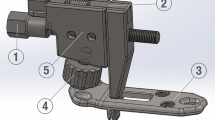Abstract
High tibial osteotomy (HTO) is an established therapy for the treatment of symptomatic varus malaligned knees. A main reason for disappointing clinical results after HTO is the under- and overcorrection of the mechanical axis due to insufficient intraoperative visualisation. Twenty legs of fresh human cadaver were randomly assigned to navigated open-wedge HTO (n=10) or conventional HTO using the cable method (n=10). Regardless of the pre-existing alignment, the aim of all operations was to align the mechanical axis to pass through 80% of the tibial plateau (beginning with 0% at the medial edge of the tibial plateau and ending with 100% at the lateral edge). This overcorrection was chosen to ensure a sufficient amount of correction. Thus, the medial proximal tibia angle (MPTA) increased by 9.1±2.9° (range 5.2°–12.3°) on the average after navigated HTO and by 8.9±2.9° (range 4.7°–12.6°) after conventional HTO. After stabilization with a fixed angle implant, the alignment was measured by CT. After navigated HTO, the mechanical axis passed the tibial plateau through 79.7% (range 75.5–85.8%). In contrast, after conventional HTO, the average intersection of the mechanical axis was at 72.1% (range 60.4–82.4%) (P=0.020). Additionally, the variability of the mean corrections was significantly lower in the navigated group (3.3% vs. 7.2%, P=0.012). Total fluoroscopic radiation time was significantly lower in the navigated group (P=0.038) whereas the mean dose area product was not significantly different (P=0.231). The time of the operative procedure was 23 min shorter after conventional HTO (P<0.001). Navigation systems provide intraoperative 3-dimensional real time control of the frontal, sagittal, and transverse axis and may increase the accuracy of open-wedge HTO. Future studies have to analyse the clinical effects of navigation on corrective osteotomies.


Similar content being viewed by others

References
Agneskirchner JD, Hurschler C, Stukenborg-Colsman C, Imhoff AB, Lobenhoffer P (2004) Effect of high tibial flexion osteotomy on cartilage pressure and joint kinematics: a biomechanical study in human cadaveric knees. Arch Orthop Trauma Surg 124:575–584
Coventry MB (1979) Upper tibial osteotomy for gonarthrosis. The evolution of the operation in the last 18 years and long term results. Orthop Clin North Am 10:191–210
Cullu E, Aydogdu S, Alparslan B, Sur H (2005) Tibial slope changes following dome-type high tibial osteotomy. Knee Surg Sports Traumatol Arthrosc 13:38–43
Dejour H, Bonnin M (1994) Tibial translation after anterior cruciate ligament rupture Two radiological tests compared. J Bone Joint Surg Br 76:745–749
Engel GM, Lippert FG III (1981) Valgus tibial osteotomy: avoiding the pitfalls. Clin Orthop 160:137–143
Fujisawa Y, Masuhara K, Shiomi S (1979) The effect of high tibial osteotomy on osteoarthritis of the knee An arthroscopic study of 54 knee joints. Orthop Clin North Am 10:585–608
Hernigou P, Medevielle D, Debeyre J, Goutallier D (1987) Proximal tibial osteotomy for osteoarthritis with varus deformity A ten to thirteen-year follow-up study. J Bone Joint Surg Am 69:332–354
Hsu RW, Himeno S, Coventry MB, Chao EY (1990) Normal axial alignment of the lower extremity and load-bearing distribution at the knee. Clin Orthop 255:215–227
Jakob RP, Murphy SB (1992) Tibial osteotomy for varus gonarthrosis: indication, planning and operative technique. Instr Course Lect 41:87–93
Krettek C, Miclau T, Grun O, Schandelmaier P, Tscherne H (1998) Intraoperative control of axes, rotation and length in femoral and tibial fractures Technical note. Injury 29(Suppl 3):C29–C39
Lobenhoffer P, Agneskirchner JD (2003) Improvements in surgical technique of valgus high tibial osteotomy. Knee Surg Sports Traumatol Arthrosc 11:132–138
Marti CB, Gautier E, Wachtl SW, Jakob RP (2004) Accuracy of frontal and sagittal plane correction in open-wedge high tibial osteotomy. Arthroscopy 20:366–372
Matthews LS, Goldstein SA, Malvitz TA, Katz BP, Kaufer H (1988) Proximal tibial osteotomy Factors that influence the duration of satisfactory function. Clin Orthop 229:193–200
Mihalko WM, Krackow KA (2001) Preoperative planning for lower extremity osteotomies: an analysis using 4 different methods and 3 different osteotomy techniques. J Arthroplasty 16:322–329
Müller W, Kentsch A, Schäfer N (2000) The elastic high tibia valgus osteotomy in the varus deformity. Oper Tech Sports Med 8:19–26
Paley D (2001) Principles of deformity correction. Springer, Berlin Heidelberg New York
Paley D, Herzenberg JE, Tetsworth K, McKie J, Bhave A (1994) Deformity planning for frontal and sagittal plane corrective osteotomies. Orthop Clin North Am 25:425–465
Saleh M, Harriman P, Edwards DJ (1991) A radiological method for producing precise limb alignment. J Bone Joint Surg Br 73:515–516
Sharma L, Song J, Felson DT, Cahue S, Shamiyeh E, Dunlop DD (2001) The role of knee alignment in disease progression and functional decline in knee osteoarthritis. JAMA 286:188–195
Sikorski JM (2004) Computer-assisted revision total knee replacement. J Bone Joint Surg Br 86:510–514
Sikorski JM, Chauhan S (2003) Computer-assisted orthopaedic surgery: do we need CAOS? J Bone Joint Surg Br 85:319–323
Sparmann M, Wolke B, Czupalla H, Banzer D, Zink A (2003) Positioning of total knee arthroplasty with and without navigation support. A prospective, randomised study. J Bone Joint Surg Br 85:830–835
Sprenger TR, Doerzbacher JF (2003) Tibial osteotomy for the treatment of varus gonarthrosis. Survival and failure analysis to twenty-two years. J Bone Joint Surg Am 85A:469–474
Acknowledgements
This study was supported by a grant of the Robert Mathys Foundation, Bettlach, Switzerland.
Author information
Authors and Affiliations
Corresponding author
Rights and permissions
About this article
Cite this article
Hankemeier, S., Hufner, T., Wang, G. et al. Navigated open-wedge high tibial osteotomy: advantages and disadvantages compared to the conventional technique in a cadaver study. Knee Surg Sports Traumatol Arthrosc 14, 917–921 (2006). https://doi.org/10.1007/s00167-006-0035-8
Received:
Accepted:
Published:
Issue Date:
DOI: https://doi.org/10.1007/s00167-006-0035-8



